Statement -1 At absolute zero, crystal tend to have a perfectly ordered arrangement
Statement -2 As the temperature increase the amount of thermal vibration of ions if their lattice sites increase abd when the vibration of a particular ion becomes large enough, it may jump out of its lattice site , causing a point defect
Statement -1 is True, Statement -2 is true : Statement -2 is a correct explanation for Statement -24
Statement -1 is True, Statement -2 is True , Statement -2 is NOT a correct explanation for Statement -24
Trapped eletrons
Statement -1 and Statement -2 both are False
Step by step video & image solution for Statement -1 At absolute zero, crystal tend to have a perfectly ordered arrangement Statement -2 As the temperature increase the amount of thermal vibration of ions if their lattice sites increase abd when the vibration of a particular ion becomes large enough, it may jump out of its lattice site , causing a point defect by Chemistry experts to help you in doubts & scoring excellent marks in Class 12 exams.
Updated on:21/07/2023Topper's Solved these Questions
Similar Questions
Energy is associated with the orientation and distribution of molecules in space. Disordered crystals have higher entropy than ordered crystals and diffused gases have higher entropy than compressed gases.
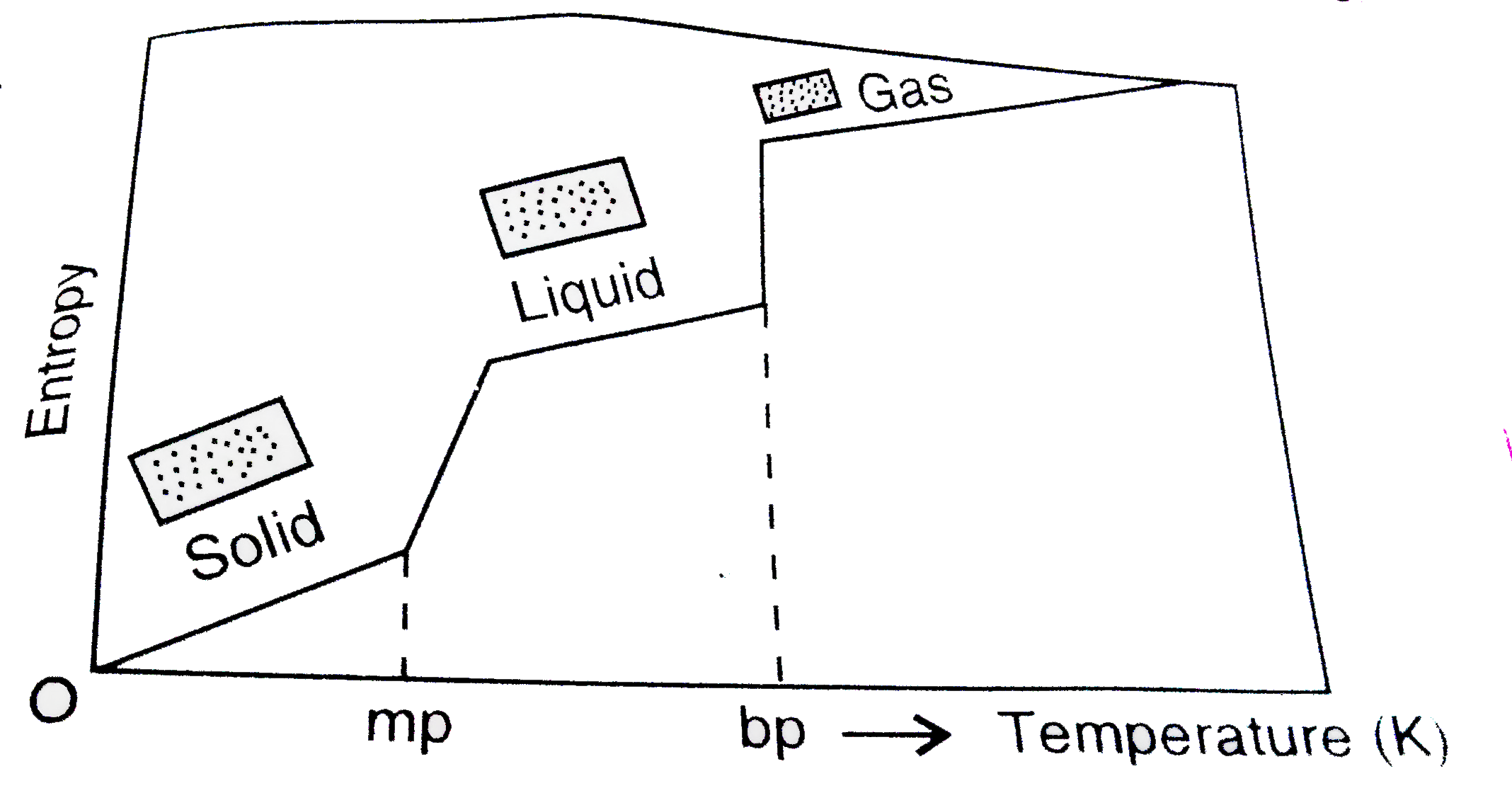
Entropy is also associated with molecular motion. As the temperature of a substance increases, random molecular motion increases hence entropy increases. Figure gives variation of entropy with temperature. At absolute zero (−273∘C) every substance is in solid state whose particles are rigidly fixed in a crystalline structure. If there is no residual orientational disorder, like that in CO, entropy of the substance is zero. Third law of thermodynamics states.
At the absolute zero of temperature the entropy of every substance become zero and does become zero in case of perfectly crystalline structure.
understand(T→0)(LtS)=0
In case of CO and NO molecules in solid state, there is randomness even at 0K due to their dipole moments hence entropy in such cases is not zero even at 0K. As the temperature is raised, the molecules begin to vibrate. The number of ways in which the vibrational energy can be distributed increases with increases in temperature and the entropy of solid increases steadily as the temperature increaes. At the melting point (mp) of the solid, there is a discontinous jump in entropy because there are many more ways of arranging the molecules in the liquid than in the solid. An even greater jump in entropy is observed at the boiling point (bp) because molecules in the gas are to free to occupy a more larger volume and randomness increases.
Which has the highest entropy per mol of the substance ?
View SolutionEnergy is associated with the orientation and distribution of molecules in space. Disordered crystals have higher entropy than ordered crystals and diffused gases have higher entropy than compressed gases.
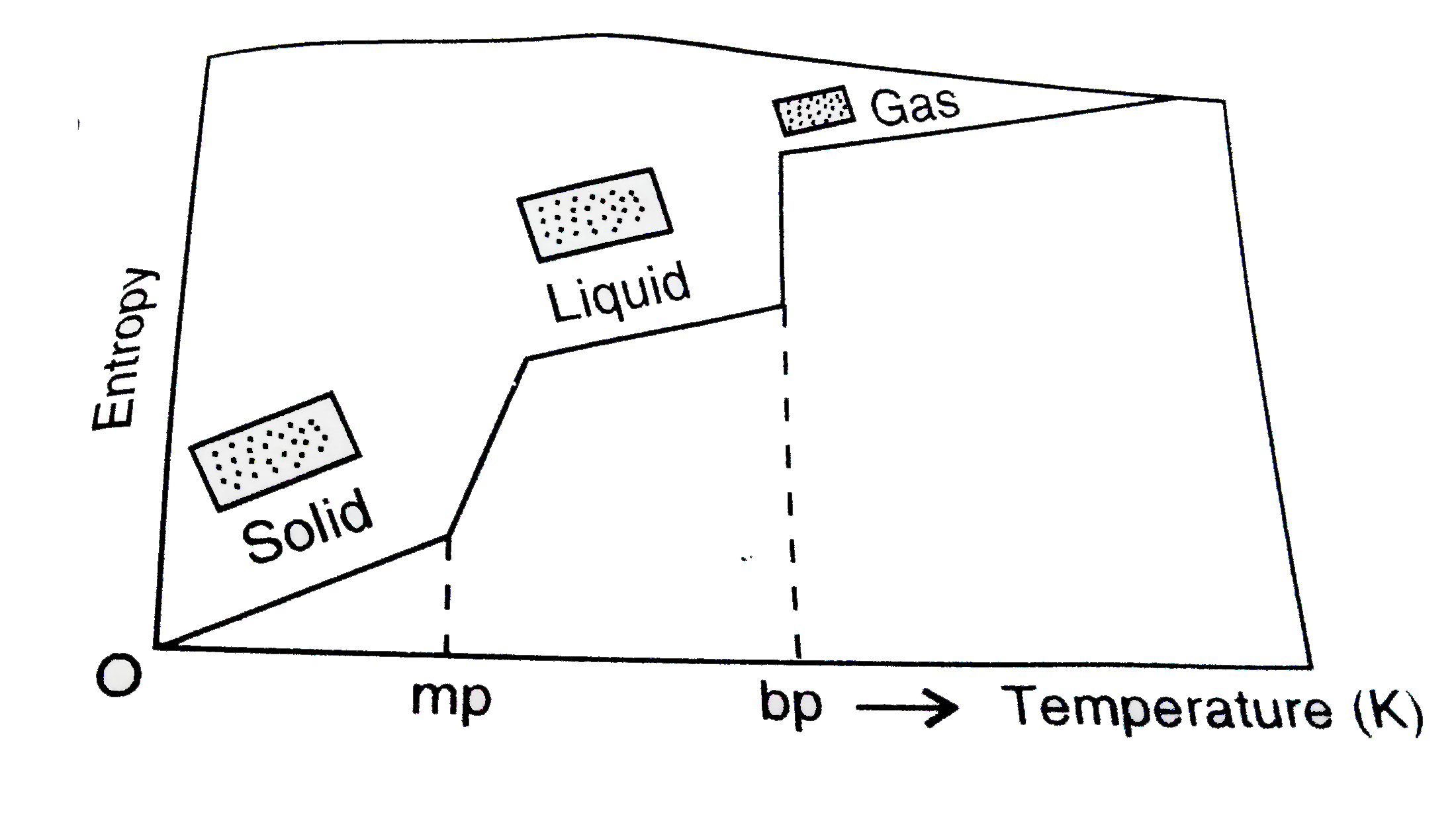
Entropy is also associated with molecular motion. As the temperature of a substance increases, random molecular motion increases hence entropy increases. Figure gives variation of entropy with temperature. At absolute zero (−273∘C) every substance is in solid state whose particles are rigidly fixed in a crystalline structure. If there is no residual orientational disorder, like that in CO, entropy of the substance is zero. Third law of thermodynamics states.
At the absolute zero of temperature the entropy of every substance become zero and does become zero in case of perfectly crystalline structure.
understand(T→0)(LtS)=0
In case of CO and NO molecules in solid state, there is randomness even at 0K due to their dipole moments hence entropy in such cases is not zero even at 0K. As the temperature is raised, the molecules begin to vibrate. The number of ways in which the vibrational energy can be distributed increases with increases in temperature and the entropy of solid increases steadily as the temperature increaes. At the melting point (mp) of the solid, there is a discontinous jump in entropy because there are many more ways of arranging the molecules in the liquid than in the solid. An even greater jump in entropy is observed at the boiling point (bp) because molecules in the gas are to free to occupy a more larger volume and randomness increases.
Which of the following process is spontaneous?
View Solution
Knowledge Check
Energy is associated with the orientation and distribution of molecules in space. Disordered crystals have higher entropy than ordered crystals and diffused gases have higher entropy than compressed gases.
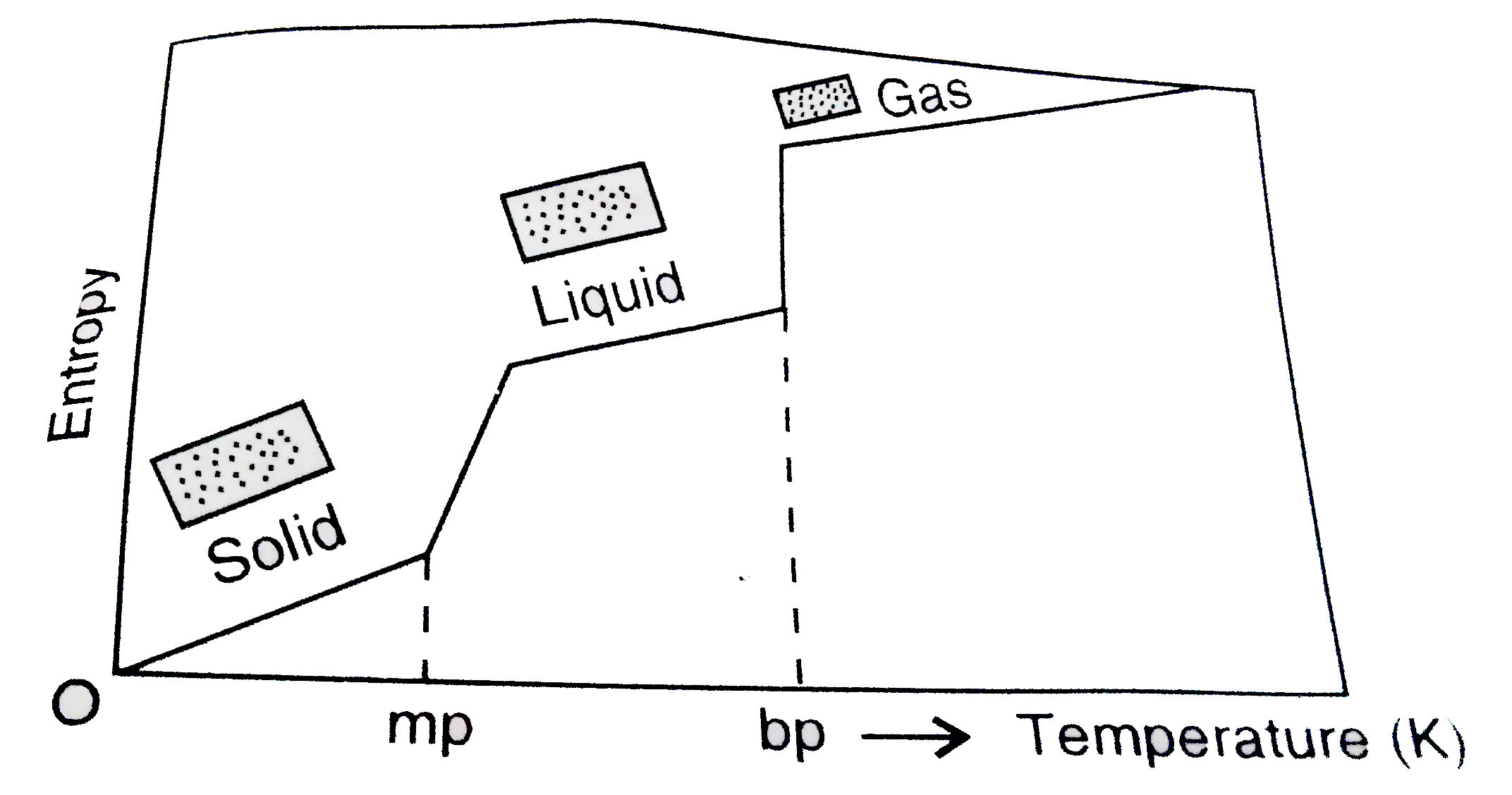
Entropy is also associated with molecular motion. As the temperature of a substance increases, random molecular motion increases hence entropy increases. Figure gives variation of entropy with temperature. At absolute zero (−273∘C) every substance is in solid state whose particles are rigidly fixed in a crystalline structure. If there is no residual orientational disorder, like that in CO, entropy of the substance is zero. Third law of thermodynamics states.
At the absolute zero of temperature the entropy of every substance become zero and does become zero in case of perfectly crystalline structure.
understand(T→0)(LtS)=0
In case of CO and NO molecules in solid state, there is randomness even at 0K due to their dipole moments hence entropy in such cases is not zero even at 0K. As the temperature is raised, the molecules begin to vibrate. The number of ways in which the vibrational energy can be distributed increases with increases in temperature and the entropy of solid increases steadily as the temperature increaes. At the melting point (mp) of the solid, there is a discontinous jump in entropy because there are many more ways of arranging the molecules in the liquid than in the solid. An even greater jump in entropy is observed at the boiling point (bp) because molecules in the gas are to free to occupy a more larger volume and randomness increases.
Out of the following statements : I, II and III. I . A system may be a complex as a human body as simple as a mixture consiting of a drop of water.
II. A large system is said to be microscopic when it consists of a large number of molecules, atoms or ions.
III. Pressure, volume, temperature and surface area are some macroscopic properties.
Select correct statementsAI, II, IIIBI, IICI, IVDII, IIIEnergy is associated with the orientation and distribution of molecules in space. Disordered crystals have higher entropy than ordered crystals and diffused gases have higher entropy than compressed gases.
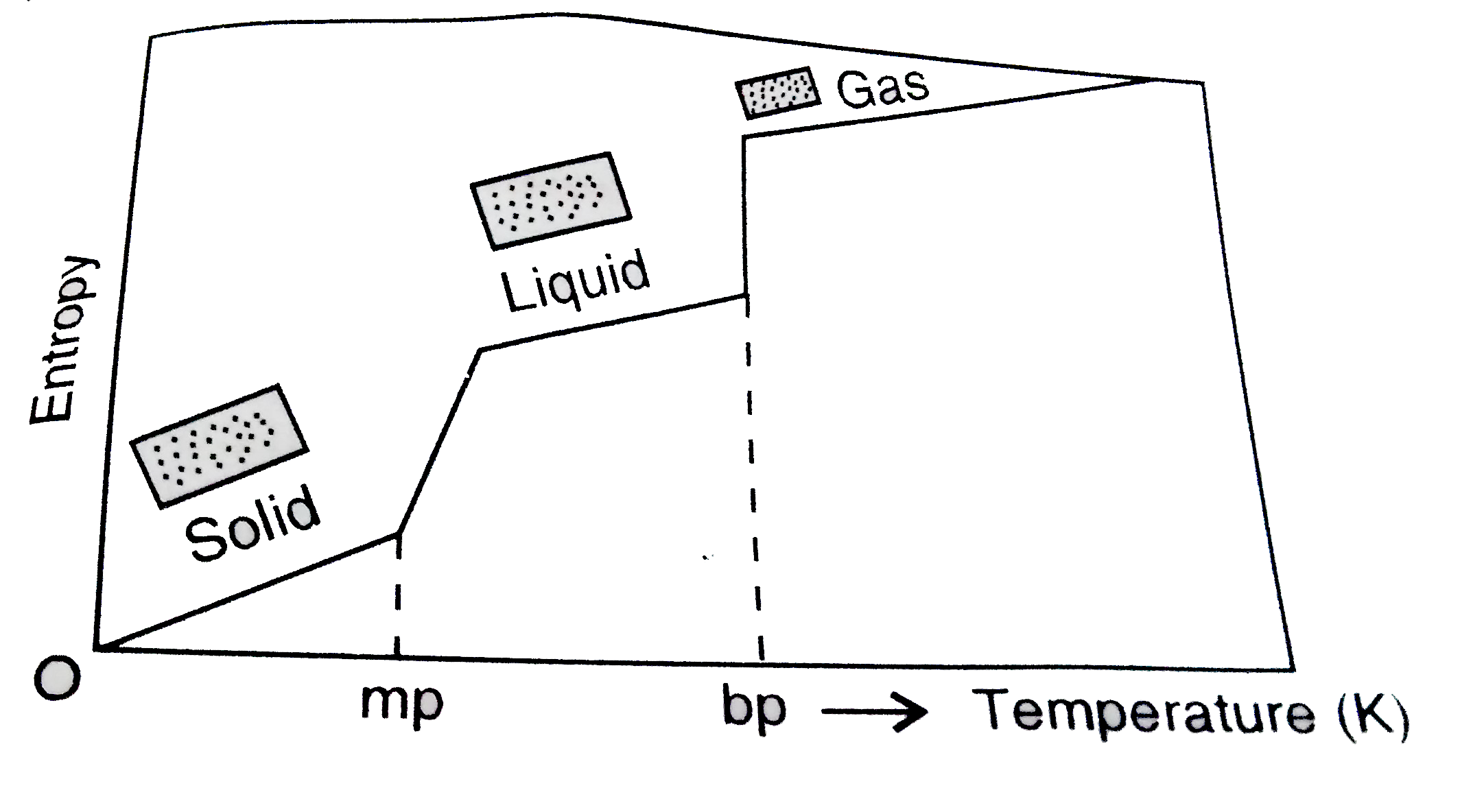
Entropy is also associated with molecular motion. As the temperature of a substance increases, random molecular motion increases hence entropy increases. Figure gives variation of entropy with temperature. At absolute zero (−273∘C) every substance is in solid state whose particles are rigidly fixed in a crystalline structure. If there is no residual orientational disorder, like that in CO, entropy of the substance is zero. Third law of thermodynamics states.
At the absolute zero of temperature the entropy of every substance become zero and does become zero in case of perfectly crystalline structure.
understand(T→0)(LtS)=0
In case of CO and NO molecules in solid state, there is randomness even at 0K due to their dipole moments hence entropy in such cases is not zero even at 0K. As the temperature is raised, the molecules begin to vibrate. The number of ways in which the vibrational energy can be distributed increases with increases in temperature and the entropy of solid increases steadily as the temperature increaes. At the melting point (mp) of the solid, there is a discontinous jump in entropy because there are many more ways of arranging the molecules in the liquid than in the solid. An even greater jump in entropy is observed at the boiling point (bp) because molecules in the gas are to free to occupy a more larger volume and randomness increases.
Predict the sign of ΔS in the system for each of the following process
(I)CO2(s)→CO2(g)
(II)CaSO4(s)→CaO(s)+SO3(g)
(III)N2(g)+3H2(g)→2NH3(g)
(IV)I2(s)→I2(aq)AIIIIIIIV+ve+ve−ve+veBIIIIIIIV+ve−ve−ve+veCIIIIIIIV−ve−ve+ve+veDIIIIIIIV+ve−ve−ve−veEnergy is associated with the orientation and distribution of molecules in space. Disordered crystals have higher entropy than ordered crystals and diffused gases have higher entropy than compressed gases.

Entropy is also associated with molecular motion. As the temperature of a substance increases, random molecular motion increases hence entropy increases. Figure gives variation of entropy with temperature. At absolute zero (−273∘C) every substance is in solid state whose particles are rigidly fixed in a crystalline structure. If there is no residual orientational disorder, like that in CO, entropy of the substance is zero. Third law of thermodynamics states.
At the absolute zero of temperature the entropy of every substance become zero and does become zero in case of perfectly crystalline structure.
understand(T→0)(LtS)=0
In case of CO and NO molecules in solid state, there is randomness even at 0K due to their dipole moments hence entropy in such cases is not zero even at 0K. As the temperature is raised, the molecules begin to vibrate. The number of ways in which the vibrational energy can be distributed increases with increases in temperature and the entropy of solid increases steadily as the temperature increaes. At the melting point (mp) of the solid, there is a discontinous jump in entropy because there are many more ways of arranging the molecules in the liquid than in the solid. An even greater jump in entropy is observed at the boiling point (bp) because molecules in the gas are to free to occupy a more larger volume and randomness increases.
For the following reaction
CaCO3(s)→CaO(s)+CO2(g)
If at 0K, ΔS of this reaction is Xcalmol−1 then entropy of CO2(g) at 0K isA−XcalB−2XcalC+XcalD0cal
Energy is associated with the orientation and distribution of molecules in space. Disordered crystals have higher entropy than ordered crystals and diffused gases have higher entropy than compressed gases.
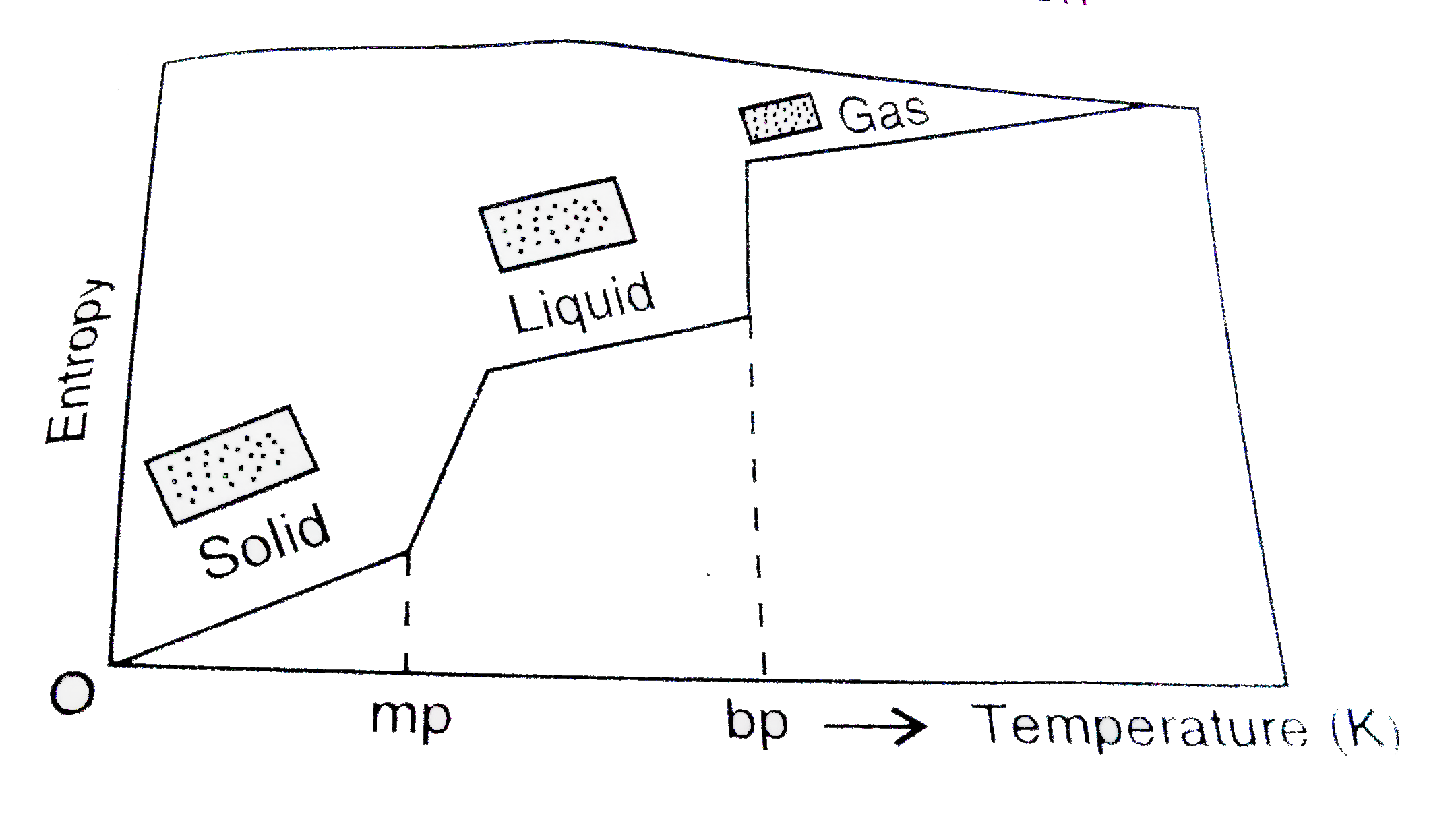
Entropy is also associated with molecular motion. As the temperature of a substance increases, random molecular motion increases hence entropy increases. Figure gives variation of entropy with temperature. At absolute zero (−273∘C) every substance is in solid state whose particles are rigidly fixed in a crystalline structure. If there is no residual orientational disorder, like that in CO, entropy of the substance is zero. Third law of thermodynamics states.
At the absolute zero of temperature the entropy of every substance become zero and does become zero in case of perfectly crystalline structure.
understand(T→0)(LtS)=0
In case of CO and NO molecules in solid state, there is randomness even at 0K due to their dipole moments hence entropy in such cases is not zero even at 0K. As the temperature is raised, the molecules begin to vibrate. The number of ways in which the vibrational energy can be distributed increases with increases in temperature and the entropy of solid increases steadily as the temperature increaes. At the melting point (mp) of the solid, there is a discontinous jump in entropy because there are many more ways of arranging the molecules in the liquid than in the solid. An even greater jump in entropy is observed at the boiling point (bp) because molecules in the gas are to free to occupy a more larger volume and randomness increases.
Which has maximum entropy of vaporisation ?
View SolutionEnergy is associated with the orientation and distribution of molecules in space. Disordered crystals have higher entropy than ordered crystals and diffused gases have higher entropy than compressed gases.

Entropy is also associated with molecular motion. As the temperature of a substance increases, random molecular motion increases hence entropy increases. Figure gives variation of entropy with temperature. At absolute zero (−273∘C) every substance is in solid state whose particles are rigidly fixed in a crystalline structure. If there is no residual orientational disorder, like that in CO, entropy of the substance is zero. Third law of thermodynamics states.
At the absolute zero of temperature the entropy of every substance become zero and does become zero in case of perfectly crystalline structure.
understand(T→0)(LtS)=0
In case of CO and NO molecules in solid state, there is randomness even at 0K due to their dipole moments hence entropy in such cases is not zero even at 0K. As the temperature is raised, the molecules begin to vibrate. The number of ways in which the vibrational energy can be distributed increases with increases in temperature and the entropy of solid increases steadily as the temperature increaes. At the melting point (mp) of the solid, there is a discontinous jump in entropy because there are many more ways of arranging the molecules in the liquid than in the solid. An even greater jump in entropy is observed at the boiling point (bp) because molecules in the gas are to free to occupy a more larger volume and randomness increases.
Which of the following process is spontaneous?
View SolutionRead the following text and answer the following questions on the basis of the same: Microwave oven:
The spectrum of electromagnetic radiation . contains a part known as microwaves. These waves have frequency and energy smaller than visible light and wavelength larger than it. What is the principle of a microwave oven and how does it work? Our objective is to cook food or warm it up. All food items such as fruit, vegetables, meat, cereals, etc., contain water as a constituent. Now, what does it mean when we say that a certain object has become warmer? When the temperature of a body rises, the energy of the random motion of atoms and molecules increases and the molecules travel or vibrate or rotate with higher energies. The frequency of rotation of water molecules is about 2.45 gigahertz (GHz). If water receives microwaves of this frequency, its molecules absorb this radiation, which is equivalent to heating up water. These molecules share this energy with neighbouring food molecules, heating up the food. One should use porcelain vessels and non metal containers in a microwave oven because of the danger of getting a shock from accumulated electric charges. Metals may also melt from heating. The porcelain container remains unaffected and cool, because its large molecules vibrate and rotate with much smaller frequencies, and thus cannot absorb microwaves. Hence, they do not get eaten up. Thus, the basic principle of a microwave oven is to generate microwave radiation of appropriate frequency in the working space of the oven where we keep food. This way energy is not wasted in heating up the vessel. In the conventional heating method, the vessel on the burner gets heated first and then the food inside gets heated because of transfer of energy from the vessel. In the microwave oven, on the other hand, energy is directly delivered to water molecules which is shared by the entire food.
When the temperature of a body rises:
View SolutionRead the following text and answer the following questions on the basis of the same: Microwave oven:
The spectrum of electromagnetic radiation . contains a part known as microwaves. These waves have frequency and energy smaller than visible light and wavelength larger than it. What is the principle of a microwave oven and how does it work? Our objective is to cook food or warm it up. All food items such as fruit, vegetables, meat, cereals, etc., contain water as a constituent. Now, what does it mean when we say that a certain object has become warmer? When the temperature of a body rises, the energy of the random motion of atoms and molecules increases and the molecules travel or vibrate or rotate with higher energies. The frequency of rotation of water molecules is about 2.45 gigahertz (GHz). If water receives microwaves of this frequency, its molecules absorb this radiation, which is equivalent to heating up water. These molecules share this energy with neighbouring food molecules, heating up the food. One should use porcelain vessels and non metal containers in a microwave oven because of the danger of getting a shock from accumulated electric charges. Metals may also melt from heating. The porcelain container remains unaffected and cool, because its large molecules vibrate and rotate with much smaller frequencies, and thus cannot absorb microwaves. Hence, they do not get eaten up. Thus, the basic principle of a microwave oven is to generate microwave radiation of appropriate frequency in the working space of the oven where we keep food. This way energy is not wasted in heating up the vessel. In the conventional heating method, the vessel on the burner gets heated first and then the food inside gets heated because of transfer of energy from the vessel. In the microwave oven, on the other hand, energy is directly delivered to water molecules which is shared by the entire food.
Why should one use porcelain vessels and non metal containers in a microwave oven ?
View SolutionRead the following text and answer the following questions on the basis of the same: Microwave oven:
The spectrum of electromagnetic radiation . contains a part known as microwaves. These waves have frequency and energy smaller than visible light and wavelength larger than it. What is the principle of a microwave oven and how does it work? Our objective is to cook food or warm it up. All food items such as fruit, vegetables, meat, cereals, etc., contain water as a constituent. Now, what does it mean when we say that a certain object has become warmer? When the temperature of a body rises, the energy of the random motion of atoms and molecules increases and the molecules travel or vibrate or rotate with higher energies. The frequency of rotation of water molecules is about 2.45 gigahertz (GHz). If water receives microwaves of this frequency, its molecules absorb this radiation, which is equivalent to heating up water. These molecules share this energy with neighbouring food molecules, heating up the food. One should use porcelain vessels and non metal containers in a microwave oven because of the danger of getting a shock from accumulated electric charges. Metals may also melt from heating. The porcelain container remains unaffected and cool, because its large molecules vibrate and rotate with much smaller frequencies, and thus cannot absorb microwaves. Hence, they do not get eaten up. Thus, the basic principle of a microwave oven is to generate microwave radiation of appropriate frequency in the working space of the oven where we keep food. This way energy is not wasted in heating up the vessel. In the conventional heating method, the vessel on the burner gets heated first and then the food inside gets heated because of transfer of energy from the vessel. In the microwave oven, on the other hand, energy is directly delivered to water molecules which is shared by the entire food.
As compared to visible light microwave has frequency and energy
View Solution
